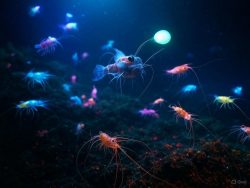The Glow of Life: How Infrared Signals Could Redefine Searching for Life On Other Planets
Posted By RichC on March 30, 2025
Over the weekend, a friend of mine sent me a link and asked for my thoughts on an article in the New Atlas, titled “Alien life might glow in the dark on infrared waterworld planets, says James Webb study” (published March 19, 2025). Perhaps even those of us who question the existence of “extraterrestrial life,” are still intrigued when unknown or new  scientific discoveries come to light.
scientific discoveries come to light.
The quest to find life beyond Earth has long captivated humanity, driving us to scan the cosmos for telltale signs of biology. Traditionally, this search has focused on biosignatures like oxygen, methane, or water vapor—chemical fingerprints familiar from our own planet. But a new study leveraging data from the James Webb Space Telescope (JWST) suggests we might need to broaden our perspective. According to researchers, alien life on water-rich exoplanets could emit a faint infrared glow, a phenomenon tied to bioluminescence. This intriguing possibility not only challenges our assumptions about what life looks like but also underscores the importance of embracing the unknown in our cosmic explorations.
Shortly before I was married, I took a bachelor camping trip with college friends to a less travelled shoreline area of North Carolina (photos from 1982 below). While sitting quietly on the beach at night, we were amazed at the beautiful glow of bioluminescence in the waves. Those who focus on ocean life know that many organisms, particularly those in the ocean’s depths, glow. From jellyfish to deep-sea fish, bioluminescence is a widespread survival strategy, used for communication, predation, or camouflage. The James Webb study posits that on exoplanets dominated by water—lacking the landmasses that shape Earth’s ecosystems—this trait could be even more prevalent. With no continents to break up their oceans, these “waterworlds” might host life that relies heavily on light to thrive in perpetual aquatic darkness. Crucially, the JWST’s infrared capabilities could detect this glow, offering a novel way to spot life where traditional biosignatures fall short. (more…)


 (@RichC)
(@RichC)








 (
(